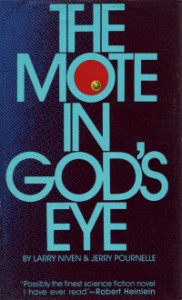
The Mote in God’s Eye is yet another book that I’ve been meaning to read for a long time. It’s co-authored by Larry Niven of Ringworld fame and is considered one of the finest examples in the sub-genre of alien first contact stories. I’ve been actively looking for stories of this type ever since I read Peter Watts’ Blindsight earlier this year. For the most part, it holds up surprisingly well for a book originally published in 1975 and the alien species at its center compares favorably even against the strangeness of today’s science-fiction.
The most dated aspect of the novel is the banality of its vision for the human civilization of the future. It basically amounts to aristocratic feudalism in space, with absolute loyalty to an emperor justified on the grounds that human unity must be upheld at all costs because of the horrific devastation interplanetary warfare can cause. To modern eyes, the novel’s glorification of military service looks positively quaint. Here the good guys are invariably the noble and hard-headed soldiers while the bad guys are the civilians, whether businessmen who are out to make a quick buck at the expense of humanity as a whole, or bleeding heart civilian scientists who are woefully naive about the harsh realities of survival.
Things get a lot more interesting when the aliens enter the picture. At first they seem woefully primitive when their alien ship is detected entering human space. Powered by a solar sail instead of the instantaneous Alderson drive, their journey has taken them over 150 years and appear to lack the protective Langston force field humans possess. When the human battlecruiser MacArthur intercepts the alien vessel, they find only a single dead pilot inside. The alien is bipedal but does not have a spine and is asymmetrical. It has two delicate arms on one side of its body and a single powerful arm on the other side. Intriguingly, while they lack the two key pieces of technology with which humans rule space, their engineering appears in many ways superior. Each of the parts that comprise the ship are individually tailored and perform multiple functions, to a degree of sophistication that humans cannot match.
Accordingly an expedition is mounted to travel to the aliens’ point of origin. MacArthur carries civilian research teams to investigate the aliens while the battleship Lenin is tasked with security and above all to protect the secrets of human technology. Their mission is to assess whether or not the aliens pose a threat to the Empire and if not to determine whether or not trade with the aliens would be beneficial. As you might expect, things don’t go smoothly when the aliens prove to be more alien than the humans think.
The Mote in God’s Eye is a hard science-fiction novel in which the appeal is all about discovering everything possible about the aliens, nicknamed Moties here. They seem peaceful and eager to share everything about themselves, even their technology and their technical skills. However the reader, along with astute and more skeptical members of the expedition, realize that the Moties are hiding something.
The book goes into considerable detail about the various classes of Moties, what each of their purposes are and how they developed. For example, they have specialized farmers who know only farming, with specially adapted hands and feet to work with soil and a mind that ignores everything except threats to crops. Similarly, their engineers are idiot-savants who have an instinctive understanding and obsession with technology but are incapable of independent thought or communication.
Overall the book lacks the pizazz of modern science-fiction but the Moties are still a very well-conceived alien species and the book deserves to be read as a good primer on alien first contact since it goes into just about every detail imaginable. After all, simply knowing that another intelligent species exists somewhere out there has lots of ramifications on our politics, religion, economy etc. and this book doesn’t miss any of this. A good, solid read despite its age.